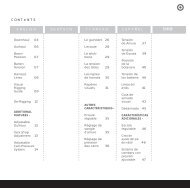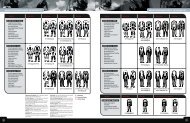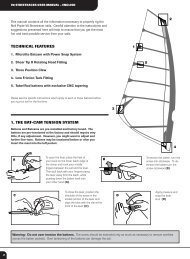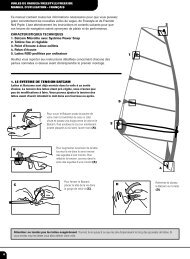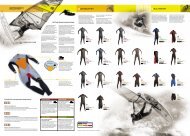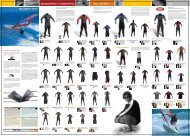shock 1997 user manual - Neil Pryde
shock 1997 user manual - Neil Pryde
shock 1997 user manual - Neil Pryde
You also want an ePaper? Increase the reach of your titles
YUMPU automatically turns print PDFs into web optimized ePapers that Google loves.
SAIL MAINTENANCE<br />
Always store your sail rolled and dry in its sailbag. Try to prevent the sail<br />
from being crushed or badly creased. Washing the sail in fresh water before<br />
storage increases its life considerably. If the foot batten is not roughly<br />
parallel with the upper battens, remove it before rolling the sail. This helps<br />
to prevent wrinkles developing in the foot and window area. The leech<br />
battens should be left in their pockets.<br />
Do Not leave the sail exposed to strong or direct sunlight. Do not use any<br />
solvents or chemicals to clean it. If the sail becomes dirty, use fresh water<br />
TUNING THE SHOCK SAILS<br />
When correctly rigged on the beach, the Shock sails will not look identical from one size to another. Each size requires<br />
slightly different tuning and will exhibit slightly different visual queues indicating correct trim. First set the sail to within<br />
the dimensions printed at the sail tack. Then follow the steps below to correctly fine tune each of the four Shock sails.<br />
Note: Over tensioning the downhaul can hinder rotation.<br />
Shock 4.6<br />
Downhaul until the leech is loose to the second batten.<br />
Then add outhaul - at least 2 - 4 cm of positive outhaul -<br />
beyond the point at which you begin to feel resistance.<br />
When over-powered, increase outhaul tension by 1 - 2<br />
cm. If the sail feels stiff and “pitchy”, it is probably<br />
over-downhauled. If the sail feels unstable or<br />
difficult to sheet in, it is probably underouthauled.<br />
Shock 5.3<br />
This sail has the firmest leech of any of the Shock range.<br />
Downhaul until the sail is just loose at the first batten, with<br />
perhaps just a little loosness (but not a floppy edge),<br />
between battens # 1 and 2. Then add outhaul - between<br />
2 and 4 centimeters beyond the point where you<br />
begin to feel tension. When over-powered, increase<br />
outhaul tension by 1 - 2 cm. If the sail feels stiff<br />
and “pitchy”, it is probably over-downhauled. If<br />
the sail feels unstable or difficult to sheet in, it<br />
is probably under-outhauled.<br />
1<br />
SAIL SAFE, HAVE FUN<br />
Sail carefully and thoughtfully around other sailors and beach <strong>user</strong>s.<br />
Before leaving the beach check all your equipment thoroughly for<br />
signs of wear or breakage. Always check the weather forecasts and<br />
take note of local conditions and potential hazards before sailing.<br />
Check for dangerous currents, and consider carefully where you<br />
might land in the event of an emergency.<br />
For further information on this or other NEILPRYDE sailing<br />
equipment contact your AUTHORIZED NEILPRYDE DEALER or our<br />
distributor in your country.<br />
2<br />
Shock 4.6 correctly tuned at near<br />
maximum downhaul.<br />
1<br />
3<br />
2<br />
3<br />
Shock 5.3 correctly tuned at near<br />
maximum downhaul.



